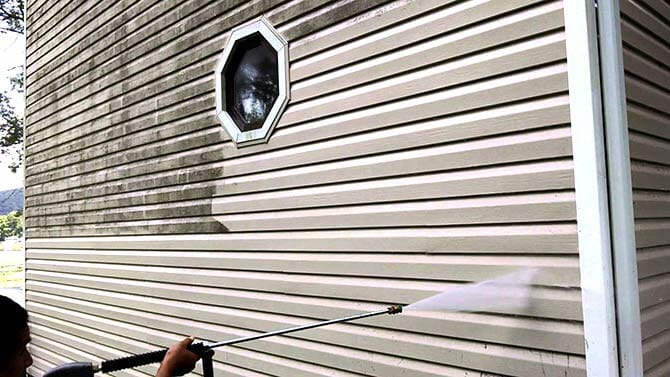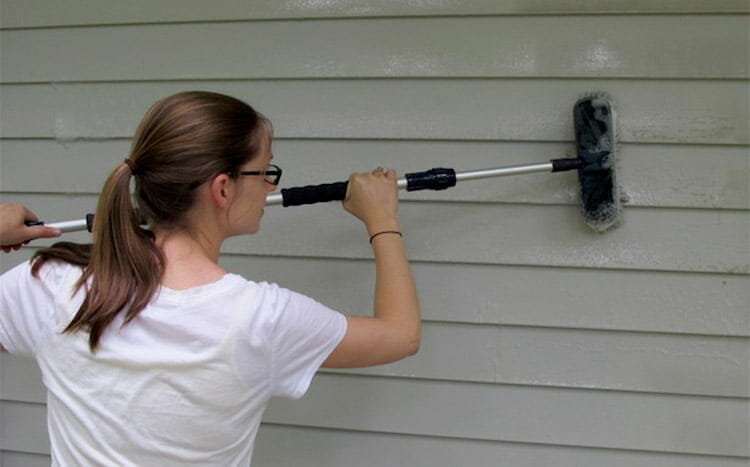Having brown or dark-green stains on your vinyl siding can be very unappealing. These stains are usually caused by mold and mildew. If left for a long time, the stains can damage your siding. Mold and mildew can also reduce the resale value of the home if left unchecked.
There are a few fast and easy ways to remove mold. You need to consider two things, the method of cleaning and the cleaning products:
The method:
- Pressure washer
- Scrub by hand
The cleaner:
- Homemade solution (bleach or vinegar)
- Commercial cleaning products
We walk you through the best and safest cleaners and methods to clean mold from vinyl siding.
3 effective methods to remove mold from vinyl siding

Vinyl siding is the most common siding material in most households because it is durable, attractive, and affordable. More so, it is a low maintenance material, but it needs regular cleaning, especially in mold-prone areas. People living in humid climates may have to clean their siding more often.
Most manufacturers provide cleaning instructions on the warranty. The instructions vary depending on the brand of vinyl siding you have. The following procedures will also come in handy if you are looking for a quick cleaning solution.
Pressure Washer
A pressure washer is an effective cleaning tool, and it can remove stubborn dirt and mold stains within minutes. However, you should be cautious of the pressure you use to avoid damaging the siding material.
Ensure you find out whether your manufacturer recommends the use of a pressure washer. If not, consider other cleaning options to avoid voiding your warranty. When pressure washing your siding:
- Ensure you set the right pressure, preferably 1,200 PSI, to prevent damaging the vinyl siding. The spray pattern should be wide enough (40 degrees) to reduce the pressure. Also, make sure you keep the nozzle moving.
- Start your cleaning from the bottom, moving slowly upwards, then rinse from top to bottom.
- Spray your pressure washer straight ahead or downwards to avoid getting water under the panels. Avoid focusing too much on one area as you may force water under the boards and cause bigger problems.
You can use hot water mixed with an effective mold-killing cleaner specially designed for cleaning siding for better results. Look for products that kill the mold before it grows. This allows for a longer period between your vinyl siding cleanings and helps maintain the paint for a longer time.
Homemade cleaning solution
If a pressure washer does not remove all the mold stains from the vinyl siding, you can formulate a simple cleaning solution. Vinegar is a great option, and it works well with most light mold and mildew stains. You can also use liquid bleach as long as you mix the right quantity with water.
Bleach
When using bleach:
- Add one quart of household bleach to a gallon of the cleaning solution you intend to use. To make the solution stronger, mix one gallon of water with 2/3 cup of the powdered household cleaning agent, and 1/3 cup of powdered laundry detergent. Then add one quart of liquid household bleach.
- Wet down the plants around the house with water and cover them with a large plastic sheet to protect them from the bleach solution. After cleaning, make sure you remove the sheet to prevent your plants from overheating damage.
- Use a sprayer or pump to wet the vinyl siding with the cleaning solution you have just made. Work from the bottom to the top and do not focus on one spot for too long to avoid forcing water through the panels.
- Let the bleach mixture sit for about ten minutes for maximum removal of the stains. After ten minutes, scrub the siding using a soft bristle brush from the bottom to the top. You can use a soft-bristle broom to reach the higher parts.
- Use a garden hose to rinse the bleach solution off your siding from top to bottom. Ensure you rinse thoroughly to make sure you remove all the bleach solution. This is because bleach can corrode the siding if left on the surface for too long.
Caution: bleach is a highly corrosive agent, so you must have proper gear when using it. Wear long pants, long sleeve shirt, rubber gloves, and goggles whenever you are using any type of bleach. More so, make sure you follow the instructions closely to avoid accidents.
Do not mix the bleach solution with other cleaners containing ammonia and vinegar or other cleaners you are warned against. When bleach is mixed with such cleaning agents, it can cause a chemical reaction and release poisonous gases that can be harmful.

Vinegar
Vinegar is also an effective cleaning solution that removes light mold and mildew stains from vinyl siding.
- Mix 30% vinegar and 70% water in a bucket and stir gently to ensure maximum mixing of the ingredients.
- Since vinegar is not dangerous to plants, you will not need to cover your flowers or other nearby plants.
- Apply the vinegar solution to the siding using a long-handled cleaning brush, then gently scrub the siding from the bottom area, and slowly work your way up.
- Rinse off the cleaning solution with a garden hose starting from the top of the siding to the bottom. This prevents water from penetrating through the siding material.
Commercial products
Homemade solutions work perfectly, but they may not effectively remove stubborn mold and mildew stains. For heavy-duty cleaning, you can use commercial cleaning products such as Wet & Forget Roof and Siding Cleaner. There are other environmentally-friendly options such as Simple Green’s House and Siding Cleaner that you can use.
- Apply the cleaning solution to your siding using a soft bristle brush or broom. You can also use a soft cloth to apply the cleaning solution. Using abrasive brushes may damage the surface of the siding and cause more headaches. Always start from the bottom part and gently move the entire length as you go to the top.
- Let the cleaning solution rest for a few minutes to work the stains and make them loose. Do not leave the solution for too long as it may dry up, forcing you to start the application process afresh.
- Use a long garden hose to rinse off the cleaning solution, debris, and dirt from the vinyl siding. Ensure the siding is still wet when rinsing with the hose to ensure all the stains come off quickly. Rinse one section after the other to make the process easier and faster.
- If there are still some stains, repeat the process all over again until your vinyl siding is sparkling clean.
Mold and mildew grow in dark and poorly lit areas. To combat their survival, ensure your vinyl siding is exposed to direct sunlight. Also, take the time to determine the cause of the mold and fix it as soon as possible to prevent frequent mold growth.
Materials you will need to clean and remove mold from vinyl siding

Cleaning and removing mold from vinyl siding is simple as long as you have the right tools and cleaning products. The following are some of the essential products you will need to remove mold from your siding.
- Soft-bristled brush/broom – a brush with soft bristles is the best to use as it will effectively remove stains and debris from the siding without damaging it. A small brush will be perfect for the lower sections of the siding, while a broom will be convenient for reaching the higher parts.
- Soft cloth – microfiber cloths are recommended because they will not scratch the vinyl siding.
- Commercial vinyl siding cleaner – commercial siding cleaning products such as Wet and Forget are specially formulated for heavy-duty cleaning of the roof or siding material. Avoid using harsh products such as undiluted bleach as they may corrode and damage the siding.
- Garden hose – a garden hose is suitable for rinsing the siding after cleaning it with detergent and siding cleaner. The garden hose you use should be long enough to reach the highest part of the siding.
- Bucket – buy a large bucket to mix your siding cleaner or detergent with water. The bucket will also be convenient to carry around the house.
FAQ’s
Will bleach discolor vinyl siding?
When used correctly, bleach will not discolor vinyl siding. Although the vinyl siding material is very tough, undiluted bleach can damage and discolor it because it is highly corrosive. When using bleach to clean vinyl siding, add one quart to one gallon of your preferred cleaning solution.
Allow the solution containing bleach to sit for 10 minutes, then scrub the siding using a soft bristle brush. Make sure you rinse thoroughly afterward to eliminate all the bleach.
How to prevent mold on vinyl siding
Regular cleaning of your vinyl siding is the best way to keep off the mold. Use a garden hose, a soft bristle brush and homemade cleaning solution to clean your siding after every few months. This way, you can keep your siding clean and in good condition for many years.
Also, try as much as you can to allow direct sunlight to reach the vinyl siding. This is because mold grows in dark and damp places. With enough light, there will be no room for mold growth.
Can I use vinegar to clean vinyl siding?
Yes, you can use household vinegar to clean your vinyl siding. Vinegar is very effective and will immediately remove mold and mildew. Mix a solution containing 70% water and 30% vinegar and use it to clean your siding. This solution will dissolve tough mold and mildew, leaving your siding looking clean and attractive.
Does Clorox damage vinyl siding?
Clorox will not damage your vinyl siding as long as you dilute it properly and rinse it thoroughly from the surface. It is very effective in removing mold and mildew, and other stubborn stains. The recommended concentration should be one gallon of Clorox to five gallons of water to produce six gallons of vinyl siding cleaning solution.
Can I pressure wash vinyl siding?
Some manufacturers do not recommend using pressure washers to clean their products. So, make sure you check the instruction manual first before using a pressure washer to avoid voiding your warranty.
Adjust it to up to 1,200 PSI and fit a 40-degree nozzle on the wand. Since it may be difficult to remove some well-established stains at this pressure, you can scrub the siding with a disinfectant then use the pressure washer. The vinyl siding material is tough, but it is not as tough as a brick. So, you should be very careful with the pressure setting you use to avoid damaging it.













